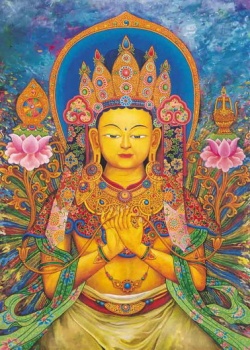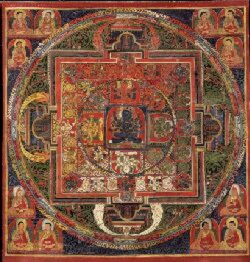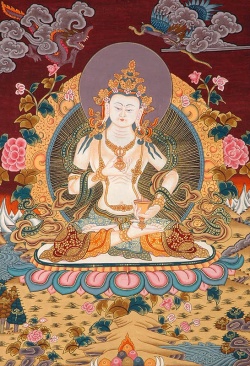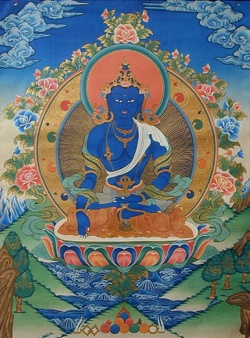Difference between revisions of "Drukpa Lineage"
m (Text replacement - "rung" to "rung") |
|||
| Line 63: | Line 63: | ||
[[Drukpa lineage]] continues to thrive and flourish and [[benefit]] all [[sentient beings]]. | [[Drukpa lineage]] continues to thrive and flourish and [[benefit]] all [[sentient beings]]. | ||
| − | It is supported by the [[state]] and given unconditional [[effort]] by all involved, from the lowest | + | It is supported by the [[state]] and given unconditional [[effort]] by all involved, from the lowest rung to the [[highest]] level. |
Nonetheless, the [[4th Gyalwang Drukpa Pema Karpo]] left a {{Wiki|prediction}} that he would return with two [[reincarnations]]. | Nonetheless, the [[4th Gyalwang Drukpa Pema Karpo]] left a {{Wiki|prediction}} that he would return with two [[reincarnations]]. | ||
Revision as of 09:46, 7 March 2016
The Drukpa Kargyu school (Dzongkha: འབྲུག་པ་བཀའ་བརྒྱུད), or simply Drukpa school, sometimes called either Dugpa or "Red Hat sect" in older sources, is a branch of the Kagyu school of Tibetan Buddhism.
It is considered to be one of the Sarma or "new" schools of Tibetan Buddhism.
Within the Drukpa Lineage, there are further sub-schools, most notably the eastern Kham tradition and middle Drukpa school which prospered in Ladakh and surrounding areas.
In Bhutan the Drukpa Lineage is the dominant school and state religion.
History
The Drukpa Lineage was founded in western Tibet by Drogon Tsangpa Gyare Yeshe Dorje (1161–1211), a student of Ling Repa who mastered the Tantric Buddhism practices of the mahamudra and six yogas of Naropa at an early age.
As a terton, or finder of spiritual relics, he discovered the text of the Six Equal Tastes, previously hidden by Rechungpa, the student of Milarepa.
While on a pilgrimage Tsangpa Gyare and his disciples witnessed a set of nine dragons roaring out of the earth and into the skies, as flowers rained down everywhere. From this incident they named their sect Drukpa.
Also important in the lineage were the root guru of Tsangpa Gyare, Ling Repa and his guru Phagmo Drupa who was in turn a principle disciple of Gampopa; as well as Dampa Sumpa , one of Rechungpa's main disciples.
A prominent disciple of Tsangpa Gyare's nephew, Onre Darma Sengye, was Phajo Drugom Zhigpo (1208–1276) who in 1222 went to establish the Drukpa Kagyu teachings in the valleys of western Bhutan.
Branches of the Drukpa Lineage
The outstanding disciples of Tsangpa Gyare Yeshi Dorje (1161–1211), the first Gyalwang Drukpa, may be divided into two categories: blood relatives and spiritual sons.
His nephew, Onre Darma Sengye (1177–1237), ascended the throne at Ralung, the main seat of the Drukpa lineage.
Darma Sengye guided the later disciples of Tsangpa Gyare, such as Gotsangpa Gonpo Dorje (1189–1258), onto the path of realization, thus becoming their guru as well. Darma Sengye's nephew and their descendants held the seat at Ralung and continued the lineage.
Gyalwa Lorepa, Gyalwa Gotsangpa and his disciple Gyalwa Yang Gonpa, are known as Gyalwa Namsum or the Three Victorious Ones in recognition of their spiritual realization.
The followers of Gyalwa Lorepa came to be called the 'Lower Drukpas'.
The followers of Gyalwa Gotsangpa came to be called the 'Upper Drukpas'.
And the followers of Onre Darma Sengye came to be called the 'Middle Drukpas'.
After the death of 4th Gyalwang Drukpa Pema Karpo in 1592, there were two rival candidates for his reincarnation.
Pagsam Wangpo, one of the candidates, was favored by the King of Tsang and prevailed.
His rival, Shabdrung Ngawang Namgyal, was then invited to Western Bhutan and eventually he unified the entire country and established Drukpa as the preeminent Buddhist school from Haa all the way to Trongsa.
The Drukpa Lineage was divided from that time on into the Northern Drukpa, or Chang Druk (Dzongkha: བྱང་འབྲུག་; Wylie: Byang-'Brug) branch in Tibet headed by the Gyalwang Drukpa
and the Southern Drukpa, or Lho Druk (Dzongkha: ལྷོ་འབྲུག་; Wylie: Lho-'Brug), based in Bhutan and headed by the Shabdrung incarnations.
Ever since Shabdrung Ngawang Namgyal appointed Pekar Jungne as the 1st Je Khenpo, the spiritual head of all monasteries in Bhutan, successive Je Khenpos have acted to date as spiritual regents of Bhutan.
Drukpa lineage continues to thrive and flourish and benefit all sentient beings.
It is supported by the state and given unconditional effort by all involved, from the lowest rung to the highest level.
Nonetheless, the 4th Gyalwang Drukpa Pema Karpo left a prediction that he would return with two reincarnations.
His other reincarnation, Pagsam Wangpo continued the lineage in Tibet.
Spread of Drukpa Lineage in Ladakh Area
Once Tagtshang Repa Ngawang Gyatso (1573–1651), a disciple of the 5th Gyalwang Drukpa Paksam Wangpo (1593–1641) and Drukpa Yongzin Ngawang Sangpo, was meditating at Ugyen dzong, a retreat cave near Kargil of Guru Padma Sambhava and Naropa, after his pilgrimage to the Swat Valley (now in Pakistan), when he received an invitation from King Jamyang Namgyal of Ladakh.
He declined the royal invitation, saying that he did not have either permission from his Guru or guidance from the Dakinis to visit the royal court of Ladakh, and returned to Tibet.
When Sengye Namgyal ascended the royal throne of Ladakh, he petitioned Drukpa Paksam Wangpo to send Tagtshang Repa to Ladakh to give spiritual guidance to the royal court and propagate the teachings of the Drukpa lineage in Ladakh.
Following the instructions of Drukpa Paksam Wangpo, Tagtshang Repa arrived in Ladakh in 1624, at the age of 50, and first founded the monastery at Hanley.
Two years later, he arrived at Hemis and was received by King Sengye Namgyal and members of the royal court.
In 1630, he built the Hemis Jangchub Ling shrine (today called Dukhang Nyingpa) and founded the Sangha.
With royal patronage, successive reincarnations of Tagtshang Repa spread the Drukpa lineage all over the kingdom of Ladakh as well as Zanskar and Lahaul.
The king of Ladakh also invited Jamgon Ngawang Gyaltsen from Bhutan to visit Ladakh, where the prime minister, the king and royal family members, warmly received him with honour and respect.
He gave many teachings to the king and the people of Ladakh and displayed many miracles.
Jamgon was particularly famous for his ability to perform miracles and make predictions.
He also proved himself to be an expert in making Zung scrolls, mandala drawings and cross-thread objects, which can still be seen in most of the dzongs in Ladakh.
Thus he also played a pivotal role in spreading the Drukpa lineage in Ladakh.
The Drukpa Lineage has more than a thousand monasteries in Tibet, Bhutan, Ladakh and other parts of Himalayas and the legacy of guiding countless beings on the path of Dharma and ultimate enlightenment for more than 800 years.
Contemporary organisation
The Lho Drukpa (Southern Drukpa) are led by the Je Khenpo (an elected office, not a tulku lineage), who is the chief abbot of the Central Monk Body.
The Chang Drukpa (Northern Drukpa) are led by Jigme Pema Wangchen, the 12th incarnation of the Gyalwang Drukpa.
In Kham, Khamtrul Rinpoche traditionally has been the most prominent Drukpa Lineage master, and still commands a huge following in Kham.
Unlike previously where the lineage was divided geographically into Northern, Middle and Southern Drukpa, the Drukpa Lineage masters today often cross these traditional borders and communicate to strengthen the lineage and the teachings.
In April 2009, the first of a yearly event known as the Annual Drukpa Council (ADC) was held on Druk Amitabha Mountain in Kathmandu, Nepal.
More than 40 masters of the lineage from India, Nepal, Bhutan and Tibet attended this event and over 10,000 lay practitioners and at least 1,000 monks and nuns or more met on this occasion.
This was the first time an annual event for the Drukpa Lineage involving all the three major branches will be held, as a concerted effort to reunite the strengths of the Drukpa Lineage and to mend the historical connections of different monasteries and organizations.
The Second ADC will be held between 6 and 15 April 2010 on Druk Amitabha Mountain again and the date and location for the subsequent gatherings will be discussed.
In July 2007, when the lineage celebrated its 800-plus-years' legacy in Shey, Ladakh, more than 100,000 attended the event that included celebrations and prayers, as well as mask dancing by 300 nuns.
This event, boasted of the first firework in the Himalayas, the first 800 sky lanterns being lit in the Himalayas and the first 12,000 bio-degradable balloons sent to the sky, was covered by international media
The event, especially the "Firework Extravaganza" was attended by non-Buddhists in the region and caused the first traffic congestion in Ladakh that lasted for more than three hours.
A documentary video based on the celebration, jointly commissioned by Hemis and Chemdrey Monasteries and narrated in Ladakhi by the locally famous Padma Shri Murup Namgyal, known as "Root and Lineage" was an immediate sold-out, it was deemed the best seller in Ladakh .
Recently, under the instruction of His Holiness the Twelfth Gyalwang Drukpa, over 5,000 trees have just been planted in the barren Shey compound where the Druk White Lotus School is located and another 25,000 trees are on the way to be planted, all done under the initiatives of "Live to Love", an engaged spiritual movement launched by His Holiness the Twelfth Gyalwang Drukpa in March 2007.
All of the funds were raised solely by His Holiness Gyalwang Drukpa through his Trusts in Europe and United Kingdom.
As of June 12, 2008, the first "Live to Love in Action" activity in support of the First Annual Drukpa Council raised over HK$450,000 for the victims in Myammar and Sichuan.
A personal supporter of His Holiness the Twelfth Gyalwang Drukpa donated Chinese RMB10million for the earthquake victims in Gansu, neighboring Sichuan, in support of the idea of "Live to Love" initiatives.
The Drukpa Lineage under the guidance of its spiritual masters, in particular His Holiness the Twelfth Gyalwang Drukpa, has established centers across the world, especially in Europe.
Name
In March 2008, the spiritual head of the Drukpa Lineage, H.H. Gyalwang Drukpa, declared his preference that:
“ .. The spiritual lineage should be known throughout the world firmly and clearly as "Dongyu Palden Drukpa", meaning the Spiritual Lineage of the Glorious Dragons or simply the "Drukpa Lineage".
I hope and pray that as holders of the Dragon Order, all of my colleagues would be mindful of their activities and their efforts.
They have to know and be clear about which household they belong to, and surely they need to be aware of others' ulterior intention. ”
He goes on to note that the "different lineages within a major Tibetan Buddhist branch are like brothers, of course some brothers do better than others,
but that doesn't mean that those doing better could self-appoint themselves as the heads of other weaker brothers' households and take over their assets, wives and children,
in the name of 'helping' and in the name of 'supporting'," and for that reason it is better that dKar-brgyud not be used any longer.
Western Perception
Nineteenth and early-twentieth century writers believed the "Dugpas" to be sorcerers focusing principally on the left-hand path traditions and various Tantric practices of Buddhism.
Alexandra David-Néel claims that the name "Dugpa" comes from the Tibetan word for thunder, as the first monastery was built during a thunderstorm.
The name "Dugpa" was used on the television show Twin Peaks to refer to a group of black magicians connected to the Black Lodge.
Monasteries
Important monasteries of the Drukpa order include:
Ralung Monastery in central Tibet just north of Bhutan
Druk Sangag Choeling Monastery
Hemis Monastery
Tashichödzong, Thimphu which houses the Central Monk Body in summer
Punakha Dzong, the winter home of the Central Monk Body
Namdruk Monastery
Kardang Monastery, the main monastery in Lahaul



